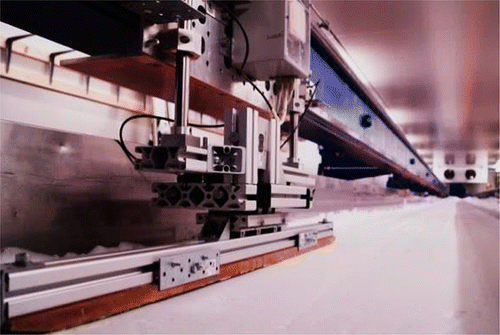How to make a faster ski

Although ski season is behind us, serious skiers are already looking ahead to next season and searching for ways to shave split-seconds off their race times. Now scientists may have a new way to help—perhaps in time for the next Winter Olympics. One team has determined how the microscopic texture of the bottoms of skis could affect their speed, depending on snow temperature. Their study appears in the journal ACS Applied Materials & Interfaces.
For many recreational skiers, rental equipment from a resort shop suffices. But for more serious athletes, a lot more consideration goes into equipment choice, down to how a set of skis is fabricated. The bottoms of skis are made of a material called ultrahigh molecular weight polyethylene. Manufacturers stone-grind the polyethylene, which roughens it. Some studies have investigated how texture on the undersides of skis affects performance. Sebastian Rohm and colleagues wanted to build on this work.
The researchers measured the shapes and sizes of the microscopic grooves that give the polyethylene its roughness and analyzed how these variables affect ski speed at different snow temperatures. Testing showed that on snow close to water's melting point, a ski surface with wide grooves and narrow plateaus between them performed faster than a surface with narrow grooves and wide plateaus. The opposite was true on colder snow. The researchers say their results could lead to improvements in how ski surfaces are prepared and used in a variety of snow conditions.
More information: Sebastian Rohm et al. Effect of Different Bearing Ratios on the Friction between Ultrahigh Molecular Weight Polyethylene Ski Bases and Snow, ACS Applied Materials & Interfaces (2016). DOI: 10.1021/acsami.6b02651
Abstract
The purpose of this study was to analyze the effect of surfaces with different bearing ratios, but similar roughness heights, on the friction between ultrahigh molecular weight polyethylene (UHMWPE) and snow. On a linear tribometer positioned inside a cold chamber, the different samples were tested over a wide range of velocities and snow temperatures. The surface roughness was measured with a focus variation microscope and analyzed using the bearing ratio curve and its parameters. The surface energy was investigated by measuring the contact angles of a polar (water) and nonpolar (diiodmethane) liquid. The friction tests showed that the bearing ratio had a major effect on the friction between UHMWPE and snow. For temperatures close to the melting point a surface with wide grooves and narrow plateaus (nonbearing surface) performed well. For cold conditions, the friction was less for a surface with narrow grooves and wide plateaus (bearing surface). Interpretations of the results are given on the basis of mixed friction, with lubricated friction being dominant at higher snow temperatures and solid–solid interaction at lower ones.
Journal information: ACS Applied Materials and Interfaces
Provided by American Chemical Society

















